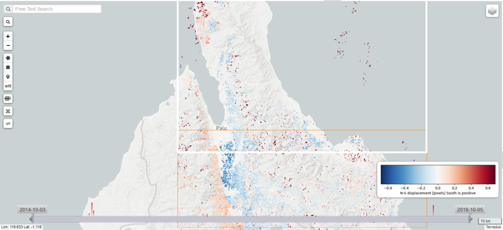In a CEOS initiative to promote and harmonize EO techniques for geohazards, service providers such as PLANETEK, TRE ALTAMIRA, GEOMATIC VENTURES, GAMMA REMOTE SENSING, CNRS-EOST and BRGM are providing access to terrain motion products on the GEP. Earth Observation techniques to monitor Terrain Motion provide key information to better understand hazards such as for instance earthquakes, volcanoes, landslides and ground subsidence. To raise interest and promote the use of these techniques, the Terrain Motion Demo is a new exercise designed in the framework of the Geohazards Lab initiative of the CEOS Working Group Disasters. The Geohazards Lab aims to establish an inclusive and comprehensive process to optimise the use of EO techniques with a primary focus on Cloud based hosted tools and services. This includes publishing and providing persistent access to Third Party products via the GEP that is ESA’s contribution to CEOS. The Terrain Motion Demo provides measurements based on different terrain motion techniques using Optical and Radar data from various missions (e.g. Sentinel-2, Pléiades and Sentinel-1). Some of the products presented were processed using GEP hosted services, while others were processed externally and then uploaded on the platform. Interested EO service providers are invited to contact the GEP to contribute to the Demo.
You can now start navigate and have a look at the different products via the Public Area on the GEP.

Mexico City subsidence - ESA/DLR InSAR - Sentinel-1 - Deformation map, Credits: ESA/DLR.
Contains modified Copernicus Sentinel-1 data (2014).

Italy, Alpi Retiche landslides - TRE ALTAMIRA SqueeSAR - PS velocity map, Credits: TRE Altamira,
Contains modified Copernicus Sentinel-1 data (2015, 2016).

Sulawesi Earthquake 2018 - MPIC-OPT - Sentinel-2 - N-S displacement, , Credits: S. Valkaniotis,
Contains modified Copernicus Sentinel-1 data (2018).